Trees Birds Mammals Fish Amphibians Reptiles
Wild Algarve
Bookshop
Hygrocybe cantharellus (Schwein.) Murrill - Goblet Waxcap
Phylum: Basidiomycota - Class: Agaricomycetes - Order: Agaricales - Family: Hygrophoraceae
Distribution - Taxonomic History - Etymology - Identification - Culinary Notes - Reference Sources
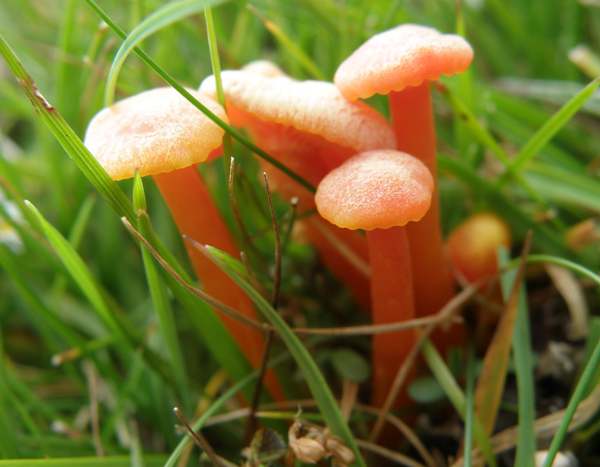
The specific epithet suggests that the caps will be infundibuliform and indeed sometimes they are – hence the common name Goblet Waxcap; however, more often than not the caps remain convex or merely become flat. If you look underneath you will see that the gills are decurrent, giving these waxcaps goblet-like silhouettes (even though there is little or no room for the wine!). Despite their liking for boggy grassland, the caps of Goblet Waxcaps are dry and scaly rather than greasy or viscid.
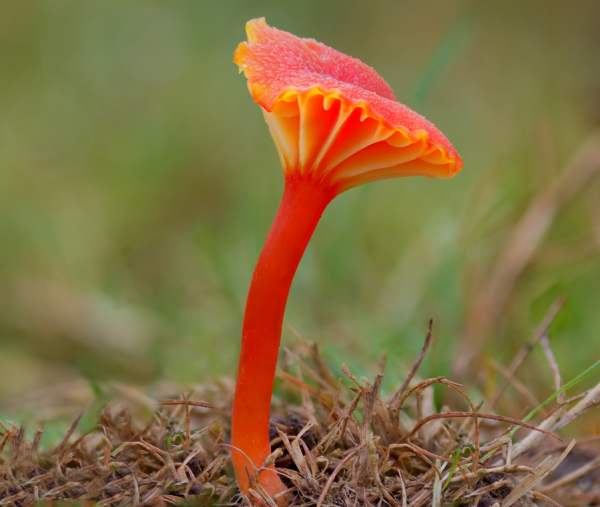
Distribution
Restricted to unimproved mossy grassland, Hygrocybe cantharellus is an infrequent but far from rare species in Britain and Ireland, and it occurs also in parts of mainland Europe. This tiny waxcap is also recorded in the USA, where it is mainly a woodland mushroom. Occasionally seen singly, more often these neat little mushrooms grow in small clusters.
Taxonomic history
Described scientifically in 1822 by American mycologist Lewis David von Schweinitz (1780 - 1834), who named it Agaricus cantharellus, the Goblet Waxcap was transferred to the genus Hygrocybe in 1911 by another American, William Alphonso Murrill (1869 - 1957), whereupon it acquired its currently accepted scientific name Hygrocybe cantharellus.
Synonyms of Hygrocybe cantharellus include Hygrophorus cantharellus (Schwein.) Fr., Hygrophorus turundus var. lepidus Boud., and Hygrocybe lepida Arnolds.
Etymology
The genus Hygrocybe is so named because fungi in this group are always very moist. Hygrocybe means 'watery head'. Canthar means a drinking cup and the suffix -ellus means diminutive; hence the specific epithet cantharellus means 'like a small drinking cup'. Some specimens do indeed become quite deeply infundibuliform (funnel-shaped) and look rather like chalices or goblets.
Identification guide
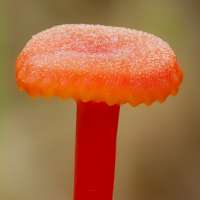 |
Cap
1 to 3.5cm across; initially convex, becoming flat-topped and eventually developing a slight depression; shades of red to reddish-orange, scales drying to almost white; incurved margin becomes crenate at maturity and is usually paler than the rest of the cap. |
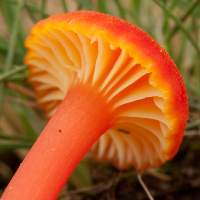 |
Gills
Slightly decurrent (as shown here) to deeply decurrent; initially almost white, becoming yellow.
Stem
3 to 6cm long and 1.5 to 3mm diameter; dry and silkily fibrillose; orange, becoming paler towards base; cylindrical; no stem ring. |
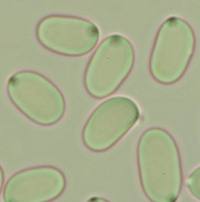 |
Spores
Ellipsoidal or ovoid to pear-shaped; 7-9 x 4.5-5.5µm; inamyloid.
Spore print
White.
Basidia
Mainly four-spored.
|
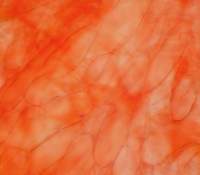 |
Gill Trama
Subregular - see photomicrograph, left.
|
Odour/taste |
Not distinctive. |
Habitat & Ecological role |
Closely cropped or mown grassland where artificial fertilisers are not spread. (In the USA this species is known to grow sometimes on well-rooted wood.)
Waxcaps have long been considered to be saprobic on the dead roots of grasses and oter grassland plants, but it is now considered likely that there is some kind of mutual relationship between waxcaps and mosses. |
Season |
September to November in Britain and Ireland. |
Similar species |
Hygrocybe coccinea has a larger orange-red cap.
Hygrocybe miniata also has a scurfy reddish cap; it is usually a bit smaller that the Goblet Waxcap and its gills are adnately attached to the stem rather than being decurrent. |
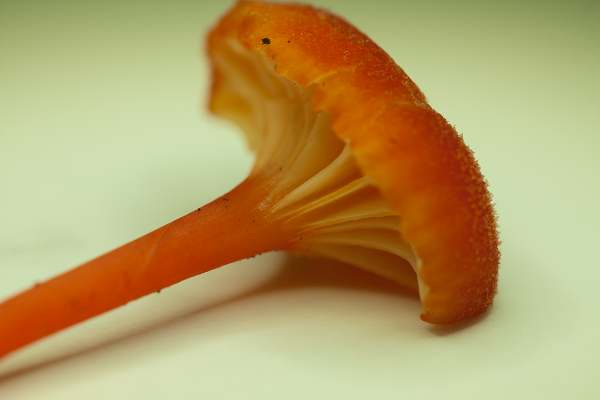
Culinary Notes
Although reported in some field guides to be edible, these tiny waxcaps are so insubstantial that they are surely not worth collecting for the pot. A collector would probably burn up far more calorioes in gathering a dish of Goblet Waxcaps than the meal would contain... so maybe these are 'slimming mushrooms'!
Reference Sources
Fascinated by Fungi, 2nd Edition, Pat O'Reilly 2016, reprinted by Coch-y-bonddu Books in 2022.
Fungi of Northern Europe, Volume 1 - The Genus Hygrocybe, David Boertmann, 2010.
Dictionary of the Fungi; Paul M. Kirk, Paul F. Cannon, David W. Minter and J. A. Stalpers; CABI, 2008
Taxonomic history and synonym information on these pages is drawn from many sources but in particular from the British Mycological Society's GB Checklist of Fungi.
Acknowledgements
This page includes pictures kindly contributed by David Kelly.
Top of page...
Fascinated by Fungi. Back by popular demand, Pat O'Reilly's best-selling 450-page hardback book is available now. The latest second edition was republished with a sparkling new cover design in September 2022 by Coch-y-Bonddu Books. Full details and copies are available from the publisher's online bookshop...